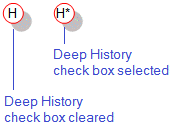History state (dictionary item)

For automation interface information about a History State, see
State (automation interface). For automation interface purposes, a History State is a State that has its UML State Type set to History.
A History State applies to the state region that contains it, and it identifies the default previous state if the region has never been entered. A History State represents deep or shallow history:
• Deep History represents the most recent active configuration of the composite state that directly contains the History State.
• Shallow History represents the most recent active substate of its containing state.
Create a History State through a Modeler explorer pane or a State Diagram:
• In a Modeler pane, right-click a State Machine or Sequential State, and select > > .
• On a State Diagram, click the  History State button, and then click the diagram background (within the frame) or within a Sequential State.
History State button, and then click the diagram background (within the frame) or within a Sequential State.
 History State button, and then click the diagram background (within the frame) or within a Sequential State.
History State button, and then click the diagram background (within the frame) or within a Sequential State.If you want a History State to represent deep history: on the Options tab of the History State's property pages, select the Deep History check box.
When used on a State Diagram, a History State's notation is as follows.

The View Options on a State Diagram allow you to show or hide the Name. By default, the Name is not shown. See
History state view options - state diagram.
On a State Diagram, you can populate History States: right-click the State Machine (frame) or Sequential State that owns the History States, and select > .
In the Dictionary pane, History States are listed in the UML\States folder.
The following sections provide information about how a History State is used in the model.
Properties
In addition to the standard properties a History State has these properties:
•
Deep History (Is Deep History through the automation interface)
Owned by
 Atomic State (through child State Diagram)
Atomic State (through child State Diagram)Owns
 Dependency —The Dependency is owned jointly by the History State and the other associated item. The access permissions you have to a Dependency are determined by the access permissions of the dependent item.
Dependency —The Dependency is owned jointly by the History State and the other associated item. The access permissions you have to a Dependency are determined by the access permissions of the dependent item. Transition —The Transition is owned jointly by the History State and the other associated item. The access permissions you have to a Transition are determined by the access permissions of the source item.
Transition —The Transition is owned jointly by the History State and the other associated item. The access permissions you have to a Transition are determined by the access permissions of the source item.Defined in these parts of the model
Shown on these diagrams
Can be linked to these dictionary items
In addition to the owning State Machine or Sequential State, a History State can be linked to the following items.
 Stereotype —To make a History State valid for a Stereotype, make State a valid item type.
Stereotype —To make a History State valid for a Stereotype, make State a valid item type. on the History State's icon indicates that the item is a
on the History State's icon indicates that the item is a
 Sequential State
Sequential State State Machine
State Machine Comment
Comment Constraint
Constraint State Model
State Model State Diagram
State Diagram Variant Diagram
Variant Diagram